
Understanding Floating Point Notation in Computer Science
This content discusses the importance of floating-point notation in computer science, highlighting the challenges and goals associated with representing real numbers. It covers concepts such as scientific notation, bias notation, encoding, and handling very small numbers and zero values in computational systems. The focus is on providing clarity on floating-point arithmetic to aid programmers in error-free real arithmetic operations.
Download Presentation

Please find below an Image/Link to download the presentation.
The content on the website is provided AS IS for your information and personal use only. It may not be sold, licensed, or shared on other websites without obtaining consent from the author. If you encounter any issues during the download, it is possible that the publisher has removed the file from their server.
You are allowed to download the files provided on this website for personal or commercial use, subject to the condition that they are used lawfully. All files are the property of their respective owners.
The content on the website is provided AS IS for your information and personal use only. It may not be sold, licensed, or shared on other websites without obtaining consent from the author.
E N D
Presentation Transcript
Quote of the day 95% of the folks out there are completely clueless about floating-point. James Gosling Sun Fellow Java Inventor 1998-02-28 CS 314 Chapter 3.1 CSE, 2017
Goals for Floating Point Standard arithmetic for reals for all computers Like two s complement Keep as much precision as possible in formats Help programmer with errors in real arithmetic + , - , Not-A-Number (NaN), exponent overflow, exponent underflow Keep encoding that is somewhat compatible with two s complement E.g., 0 in Fl. Pt. is 0 in two s complement Make it possible to sort without needing to do floating point comparison CS 314 Chapter 3.2 CSE, 2017
Scientific Notation (e.g., Base 10) Normalized scientific notation (aka standard form or exponential notation): r x Ei, E is exponent (usually 10), i is a positive or negative integer, r is a real number 1.0, < 10 Normalized => No leading 0s 61 is 6.10 x 102, 0.000061 is 6.10 x10-5 CS 314 Chapter 3.3 CSE, 2017
Scientific Notation (e.g., Base 10) (r x ei) x (s x ej) = (r x s) x ei+j (1.999 x 102) x (5.5 x 103) = (1.999 x 5.5) x 105 = 10.9945 x 105 = 1.09945 x 106 (r x ei) / (s x ej) = (r / s) x ei-j (1.999 x 102) / (5.5 x 103) = 0.3634545 x 10-1 = 3.634545 x 10-2 For addition/subtraction, you first must align: (1.999 x 102) + (5.5 x 103) = (.1999 x 103) + (5.5 x 103) = 5.6999 x 103 CS 314 Chapter 3.4 CSE, 2017
Floating Point: Representing Very Small Numbers Zero: Bit pattern of all 0s is encoding for 0.000 But 0 in exponent should mean most negative exponent (want 0 to be next to smallest real) Can t use two s complement (1000 0000two) Bias notation: subtract bias from exponent Single precision uses bias of 127; DP uses 1023 0 uses , NaN uses 1111 1111two=> 255-127 = +128 Smallest SP real can represent: 1.00 00 x 2-126 Largest SP real can represent: 1.11 11 x 2+127 0000 0000two=> 0-127 = -127; CS 314 Chapter 3.5 CSE, 2017
Bias Notation (+127) How it is interpreted How it is encoded , NaN Getting closer to zero Zero CS 314 Chapter 3.6 CSE, 2017
What About Real Numbers in Base 2? r x Ei, E where exponent is (2), i is a positive or negative integer, ris a real number 1.0, < 2 Computers version of normalized scientific notation called Floating Point notation CS 314 Chapter 3.7 CSE, 2017
Floating Point Numbers 32-bit word has 232 patterns, so must be approximation of real numbers 1.0, < 2 IEEE 754 Floating Point Standard: 1 bit for sign (s) of floating point number 8 bits for exponent (E) 23 bits for fraction (F) (get 1 extra bit of precision if leading 1 is implicit) (-1)s x (1 + F) x 2E Can represent from 2.0 x 10-38 to 2.0 x 1038 CS 314 Chapter 3.8 CSE, 2017
Floating Point Numbers What about bigger or smaller numbers? IEEE 754 Floating Point Standard: Double Precision (64 bits) 1 bit for sign (s) of floating point number 11 bits for exponent (E) 52 bits for fraction (F) (get 1 extra bit of precision if leading 1 is implicit) (-1)s x (1 + F) x 2E Can represent from 2.0 x 10-308 to 2.0 x 10308 32 bit format called Single Precision CS 314 Chapter 3.9 CSE, 2017
Representing Big (and Small) Numbers What if we want to encode the approx. age of the earth? 4,600,000,000 or 4.6 x 109 or the weight in kg of one a.m.u. (atomic mass unit) 0.0000000000000000000000000166 or 1.6 x 10-27 There is no way we can encode either of the above in a 32-bit integer. Floating point representation (-1)sign x F x 2E Still have to fit everything in 32 bits (single precision) s E (exponent) F (fraction) 1 bit 8 bits 23 bits The base (2, not 10) is hardwired in the design of the FPALU More bits in the fraction (F) or the exponent (E) is a trade-off between precision (accuracy of the number) and range (size of the number) CS 314 Chapter 3.10 CSE, 2017
Exception Events in Floating Point Overflow (floating point) happens when a positive exponent becomes too large to fit in the exponent field Underflow (floating point) happens when a negative exponent becomes too large to fit in the exponent field - + - largestE -smallestF - largestE +smallestF + largestE -largestF + largestE +largestF One way to reduce the chance of underflow or overflow is to offer another format that has a larger exponent field Double precision takes two MIPS words s E (exponent) F (fraction) 1 bit 11 bits 20 bits F (fraction continued) 32 bits CS 314 Chapter 3.11 CSE, 2017
Father of the Floating point standard IEEE Standard 754 for Binary Floating-Point Arithmetic. 1989 ACM Turing Award Winner! Prof. Kahan www.cs.berkeley.edu/~wkahan/ /ieee754status/754story.html CS 314 Chapter 3.12 CSE, 2017
IEEE 754 FP Standard Most (all?) computers these days conform to the IEEE 754 floating point standard (-1)sign x (1+F) x 2E-bias Formats for both single and double precision F is stored in normalized format where the msb in F is 1 (so there is no need to store it!) called the hidden bit To simplify sorting FP numbers, E comes before F in the word and E is represented in excess (biased) notation where the bias is -127 (-1023 for double precision) so the most negative is 00000001 = 21-127 = 2-126 and the most positive is 11111110 = 2254-127 = 2+127 Examples (in normalized format) Smallest+: 0 00000001 1.00000000000000000000000 = 1 x 21-127 Zero: 0 00000000 00000000000000000000000 = true 0 Largest+: 0 11111110 1.11111111111111111111111 = 1.02 x 2-1 = 0.7510 x 24 = 2-2-23 x 2254-127 0 01111110 1.00000000000000000000000 0 10000010 1.10000000000000000000000 CS 314 Chapter 3.14 CSE, 2017
Ex: Converting Binary FP to Decimal BEE00000His the hex. Rep. Of an IEEE 754 SP FP number 10111 1101 110 0000 0000 0000 0000 0000 (-1)S x (1 + Significand) x 2(Exponent-127) Sign: 1 => negative Exponent: 0111 1101two = 125ten Bias adjustment: 125 - 127 = -2 Significand: 1 + 1x2-1+ 1x2-2 + 0x2-3 + 0x2-4 + 0x2-5 +... =1+2-1 +2-2 = 1+0.5 +0.25 = 1.75 Represents: -1.75tenx2-2 = -0.4375 (= -4.375x10-1 ) CS 314 Chapter 3.15 CSE, 2017
Ex: Converting Decimal to FP -1.275 x 101 1. Denormalize: -12. 75 2. Convert integer part: 12 = 8 + 4 = 11002 3. Convert fractional part: .75 = .5 + .25 = .112 4. Put parts together and normalize: 1100.11 = 1.10011 x 23 5. Convert exponent: 127 + 3 = 128 + 2 = 1000 00102 11000 0010 100 1100 0000 0000 0000 0000 The Hex rep. is C14C0000H CS 314 Chapter 3.16 CSE, 2017
Representation for 0 How to represent 0? exponent: all zeros significand: all zeros What about sign? Both cases valid. +0: 0 00000000 00000000000000000000000 -0: 1 00000000 00000000000000000000000 CS 314 Chapter 3.17 CSE, 2017
Representation for +/- infinity How to represent + /- ? Exponent : all ones (11111111B = 255) Significand: all zeros + : 0 11111111 00000000000000000000000 - : 1 11111111 00000000000000000000000 Operations 5 / 0 = + , -5 / 0 = - 5+(+ ) = + , (+ )+(+ ) = + 5 - (+ ) = - , (- ) - (+ ) = - etc CS 314 Chapter 3.18 CSE, 2017
Representation for Not a Number Sqrt (- 4.0) = ? 0/0 = ? Called Not a Number (NaN) - How to represent NaN Exponent = 255 Significand: nonzero NaNs can help with debugging Operations sqrt (-4.0) = NaN 0/0 = NaN op (NaN,x) = NaN + +(- ) = NaN + - (+ ) = NaN / = NaN etc. CS 314 Chapter 3.19 CSE, 2017
Representation for Denorms( ) What have we defined so far? (for SP) Exponent Significand Object Used to represent Denormalized numbers 0 0 +/-0 0 nonzero Denorms 1-254 anything Norms implicit leading 1 255 0 +/- infinity 255 nonzero NaN CS 314 Chapter 3.20 CSE, 2017
Group Discussion 1: Questions about IEEE 754 Four students form a group and discuss the following question. What about following type converting: will it output true? if ( i == (int) ((float) i) ) { printf ( true ); } if ( f == (float) ((int) f) ) { printf ( true ); CS 314 Chapter 3.21 } CSE, 2017
Question II about IEEE 754 How about FP add associative? (X+Y)+Z=X+(Y+Z) x = 1.5 x 1038, y = 1.5 x 1038, z = 1.0 (x+y)+z = ( 1.5x1038+1.5x1038 )+1.0 = 1.0 x+(y+z) = 1.5x1038+ (1.5x1038+1.0) = 0.0 CS 314 Chapter 3.22 CSE, 2017
IEEE 754 FP Standard Encoding Special encodings are used to represent unusual events infinity for division by zero NAN (not a number) for the results of invalid operations such as 0/0 True zero is the bit string all zero Single Precision E (8) 0000 0000 0000 0000 Double Precision E (11) 0000 0000 0000 0000 Object Represented F (23) 0 nonzero F (52) 0 nonzero true zero (0) denormalized number 0111 1111 to +127,-126 1111 1111 1111 1111 anything 0111 1111 to +1023,-1022 1111 1111 1111 1111 anything floating point number - 0 infinity nonzero not a number (NaN) + 0 nonzero CS 314 Chapter 3.23 CSE, 2017
Support for Accurate Arithmetic IEEE 754 FP rounding modes Always round up (toward + ) Always round down (toward - ) Truncate Round to nearest even (when the Guard || Round || Sticky are 100) always creates a 0 in the least significant (kept) bit of F Rounding (except for truncation) requires the hardware to include extra F bits during calculations Guard bit used to provide one F bit when shifting left to normalize a result (e.g., when normalizing F after division or subtraction) Round bit used to improve rounding accuracy Sticky bit used to support Round to nearest even; is set to a 1 whenever a 1 bit shifts (right) through it (e.g., when aligning F during addition/subtraction) F = 1 . xxxxxxxxxxxxxxxxxxxxxxx G R S CS 314 Chapter 3.24 CSE, 2017
Floating Point Addition Addition (and subtraction) ( F1 2E1) + ( F2 2E2) = F3 2E3 Step 0: Restore the hidden bit in F1 and in F2 Step 1: Align fractions by right shifting F2 by E1 - E2 positions (assuming E1 E2) keeping track of (three of) the bits shifted out in G R and S Step 2: Add the resulting F2 to F1 to form F3 Step 3: Normalize F3 (so it is in the form 1.XXXXX ) - If F1 and F2 have the same sign F3 [1,4) 1 bit right shift F3 and increment E3 (check for overflow) - If F1 and F2 have different signs F3 may require many left shifts each time decrementing E3 (check for underflow) Step 4: Round F3 and possibly normalize F3 again Step 5: Rehide the most significant bit of F3 before storing the result CS 314 Chapter 3.25 CSE, 2017
Floating Point Addition Example Add (0.5 = 1.0000 2-1) + (-0.4375 = -1.1100 2-2) Hidden bits restored in the representation above Shift significand with the smaller exponent (1.1100) right until its exponent matches the larger exponent (so once) Step 0: Step 1: Step 2: Add significands 1.0000 + (-0.111) = 1.0000 0.111 = 0.001 Normalize the sum, checking for exponent over/underflow 0.001 x 2-1 = 0.010 x 2-2 = .. = 1.000 x 2-4 Step 3: Step 4: The sum is already rounded, so we re done Rehide the hidden bit before storing Step 5: CS 314 Chapter 3.27 CSE, 2017
Exercise Given A=2.6125 101, B=4.150390625 10-1, Calculate the sum of A and B by hand, assuming A and B are stored by the following format, Assume 1 guard, 1 round bit, and 1 sticky bit, and round to the nearest even. Show all the steps. Sign Exponent Fraction 1 bit 5 bits 10 bits S E F CS 314 Chapter 3.28 CSE, 2017
Solution: a. 2.6125 101 + 4.150390625 10 1 2.6125 101 = 26.125 = 11010.001 = 1.1010001000 24 4.150390625 10 1 = .4150390625 = .011010100111 =1.1010100111 2 2 Shift binary point 6 to the left to align exponents, GR 1.1010001000 00 +.0000011010 10 0111 (Guard = 1, Round = 0, Sticky = 1) -------------------- 1.1010100010 10 In this case the extra bits (G,R,S) are more than half of the least significant bit (0). Thus, the value is rounded up. 1.1010100011 24 = 11010.100011 20 = 26.546875 = 2.6546875 101 CS 314 Chapter 3.29 CSE, 2017
Floating Point Multiplication Multiplication ( F1 2E1) x ( F2 2E2) = F3 2E3 Step 0: Restore the hidden bit in F1 and in F2 Step 1: Add the two (biased) exponents and subtract the bias from the sum, so E1 + E2 127 = E3 also determine the sign of the product (which depends on the sign of the operands (most significant bits)) Step 2: Multiply F1 by F2 to form a double precision F3 Step 3: Normalize F3 (so it is in the form 1.XXXXX ) - Since F1 and F2 come in normalized F3 [1,4) 1 bit right shift F3 and increment E3 - Check for overflow/underflow Step 4: Round F3 and possibly normalize F3 again Step 5: Rehide the most significant bit of F3 before storing the result CS 314 Chapter 3.30 CSE, 2017
Floating Point Multiplication Example Multiply (0.5 = 1.0000 2-1) x (-0.4375 = -1.1100 2-2) Hidden bits restored in the representation above Step 0: Step 1: Add the exponents (not in bias would be -1 + (-2) = -3 and in bias would be (-1+127) + (-2+127) 127 = (-1 -2) + (127+127-127) = -3 + 127 = 124 Multiply the significands 1.0000 x 1.110 = 1.110000 Step 2: Normalized the product, checking for exp over/underflow 1.110000 x 2-3 is already normalized Step 3: Step 4: The product is already rounded, so we re done Rehide the hidden bit before storing Step 5: CS 314 Chapter 3.32 CSE, 2017
MIPS Floating Point Instructions MIPS has a separate Floating Point Register File ($f0, $f1, , $f31) (whose registers are used in pairs for double precision values) with special instructions to load to and store from them lwcl $f1,54($s2) #$f1 = Memory[$s2+54] swcl $f1,58($s4) #Memory[$s4+58] = $f1 And supports IEEE 754 single add.s $f2,$f4,$f6 #$f2 = $f4 + $f6 and double precision operations add.d $f2,$f4,$f6 #$f2||$f3 = $f4||$f5 + $f6||$f7 similarly for sub.s, sub.d, mul.s, mul.d, div.s, div.d CS 314 Chapter 3.33 CSE, 2017
MIPS Floating Point Instructions, Cont And floating point single precision comparison operations c.x.s $f2,$f4 #if($f2 < $f4) cond=1; else cond=0 where x may be eq, neq, lt, le, gt, ge and double precision comparison operations c.x.d $f2,$f4 #$f2||$f3 < $f4||$f5 cond=1; else cond=0 And floating point branch operations bclt 25 #if(cond==1) go to PC+4+25 bclf 25 #if(cond==0) go to PC+4+25 CS 314 Chapter 3.34 CSE, 2017
Frequency of Common MIPS Instructions Only included those with >3% and >1% SPECint 5.2% 9.0% 4.0% 4.4% 3.3% 18.6% 7.6% 3.7% 8.6% 8.4% 9.9% 3.1% 3.4% SPECfp 3.5% 7.2% 1.2% 1.9% 0.5% 5.8% 2.0% 0.1% 2.2% 1.4% 2.3% 0.3% 0.8% SPECint 0.0% 0.0% 0.0% 0.0% 0.0% 0.0% 0.0% 0.0% 0.0% 0.0% 1.3% SPECfp 10.6% 4.9% 15.0% 1.5% 1.8% 2.4% 17.5% 4.9% 4.2% 1.1% 0.0% addu addiu or sll lui lw sw lbu beq bne slt slti sltu add.d sub.d mul.d add.s sub.s mul.s l.d s.d l.s s.s lhu CS 314 Chapter 3.35 CSE, 2017
Assignment III 3.6, 3.8, 3.11, 3.14 Coding Assignment Objective: Understanding the applications of IEEE 754 floating points in real- world machine Task 1: In your machine, what is the accuracy for single precision and double precision (or the number of bits required for single/double precision floating)? Please use a simple program to demonstrate it. Task 2: Run a program to obtain the results of -8.0/0 and sqrt -4.0 in your machine. Reports: 1. Submit your codes and execution results by printing your screen. 2. Answer the following questions: 1)What are the accuracy of float and double in your machine. 2)How to represent infinite and NAN in your machine. Due: Nov. 15 CS 314 Chapter 3.36 CSE, 2017








